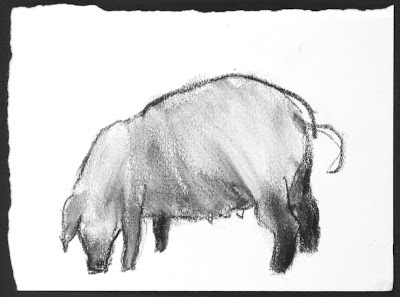Anyone who follows me on Twitter knows that I have recently started using a little drawing app on my iPhone. After trying a few different ones, I eventually settled on Sketchbook Mobile by Autodesk. It's actually a great little program with a wide range of tools to use that, in the right hands, can produce some pretty sophisticated images.
Me, I just stick to the basic stuff. I like to draw so I mainly use the tools that look a little like the pencils and pens I carry around in my bag normally. Maybe it's my early days as a cartoon animator back in Philadelphia, but I also like to play around with adding colour on a different layer that I can edit separately from the original drawing. I can then incorporate the colour to the sketch by placing the layer with the colour under the one with the lines - just like painting the back of an animation cel (back in the days when animators did that sort of thing).
It's a fun app to use, and I invested in a little stylus as well that allows me to draw with something that resembles a pencil instead of having to use my finger all the time. It's just like drawing in a sketchbook, except it's on the phone, right?
Well, not exactly.
But before I get into the differences, let me start with the similarities. In some basic ways, drawing with the iPhone and drawing on paper are a lot alike. The feeling of "flow" that I experience when drawing with a pen and paper, also comes on when I am drawing with an electronic pencil in the app. When I'm involved in the process of actual mark making, these two experiences share very similar qualities. In both cases, I completely lose track of time and my connection with whatever I am drawing seems to become tightly fused through the act of looking and drawing. The feeling is hard to describe, but I know when it's there - and when it isn't.
The thing that I've noticed is that this feeling of flow and connection is broken when using the app whenever I need to engage the interface to change to a different drawing tool or select a new colour to use. This doesn't happen when working in traditional media. When I'm working on paper using physical materials, choosing a different pencil or dipping a brush into a different paint colour is all part of the same experience of being in connection with the drawing process. But with the on-screen app, this process of having to use an interface to mediate my decisions about which pencil, pen, brush, or colour to use seems to engage a different part of my brain. My decision-making process has to conform to the rules and limitations of the software. This activation of a different, and no doubt logical, thinking process often jolts me out of the sense of flow and connection with the drawing process. In this moment of choosing a new tool, I can clearly feel a different thought process taking over; one that is more distant and judging. New questions about the image pop into my head, and I can feel a different editorial conversation starting to emerge. In that moment, I'm no longer connected to the image. I am a viewer making a critical assessment of its worth as an object in the world.
Now, is this such a big deal? Not really I guess. It's just that we often assume that these new tools that are being used with increasing frequency by artists and designers are experientially synonymous with traditional physical media. But they're not the same. We engage different parts of our brains when using these digital tools, and the artwork we produce using them is naturally altered as a result.
The tools and materials we use to draw require different kinds of thinking and engagement in our brains. The sense of flow that is so fundamental to the image making process is, I think, interrupted by this constant switching between right brain intuitive connection to left brain logical selection.
Now, I'm not making a value judgement here. Artists using digital tools can, and do, create fantastic and moving imagery. I'm just noting that these two experiences of drawing are not the same, so let's not pretend they are.
Does this matter? Most of the time, probably not. But sometimes it certainly does. If we are more attentive to the differences in how these digital tools change both the experience, and therefore, the output of our creative work, we may cast a more critical eye when choosing the right tools for the job.
All that said, here are a selection of a few recent digital drawings.









































